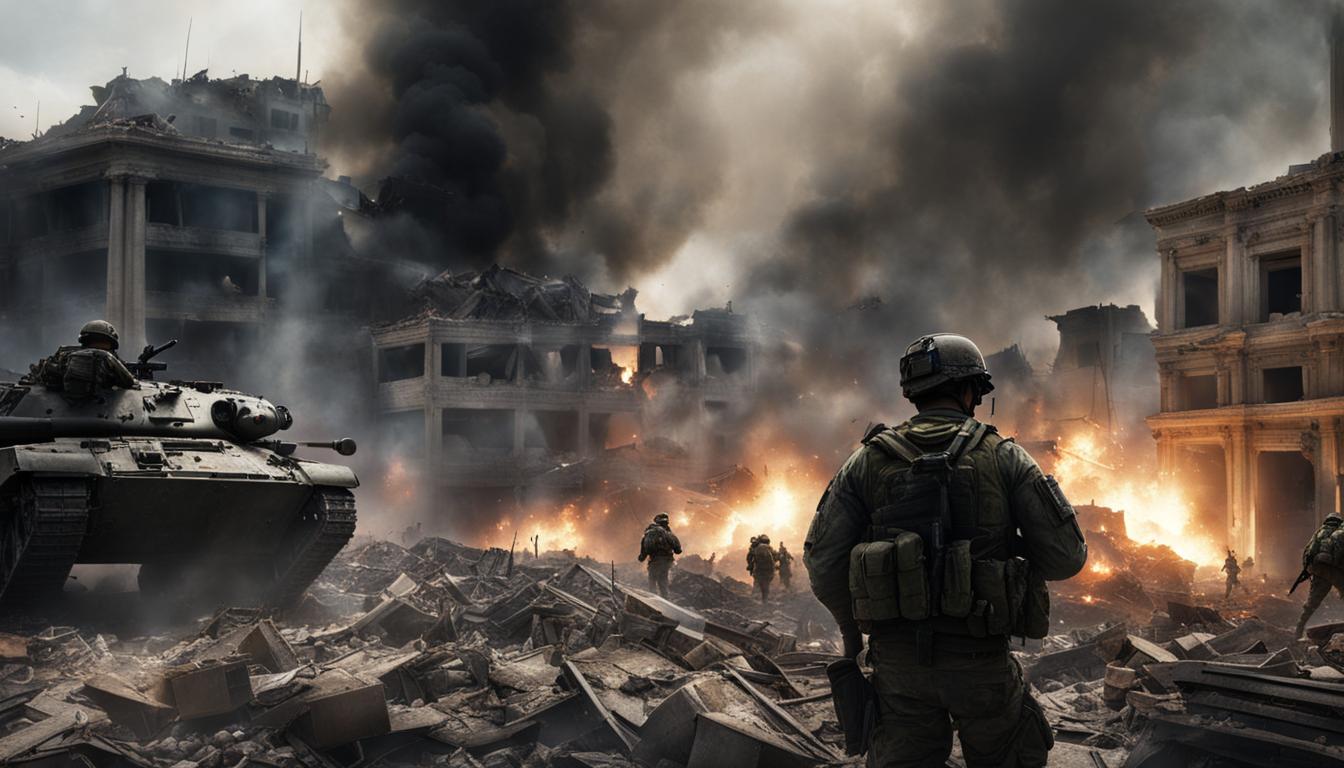The history of US wars is filled with significant military conflicts and major battles that have shaped the nation. From the fight for independence to conflicts against imperialism and terrorism, United States wars hold a crucial place in the nation’s history. Understanding the historical context, impacts, and significance of these wars is essential in comprehending the journey of the United States.
Key Takeaways:
- US wars have played a pivotal role in shaping the nation and its ideals.
- Major conflicts such as the American Revolution and the Civil War paved the way for the birth of the United States and the preservation of the Union.
- The US involvement in World War I and World War II had a global impact.
- The Korean War and the Vietnam War were significant Cold War conflicts.
- Wars with the Middle East, including the Gulf War and the ongoing War on Terror, aimed to combat terrorism and stabilize the region.
The American Revolution: Birth of a Nation
The American Revolution, also known as the Revolutionary War, was a pivotal conflict that marked the birth of the United States as an independent nation. It was fought between the American colonies and Great Britain from 1775 to 1783. This war was driven by the colonists’ desire to break free from British rule and establish their own democratic government.
Key figures like George Washington emerged as leaders during the American Revolution, guiding the colonists through a long and arduous struggle against the powerful British army. The signing of the Treaty of Paris in 1783 formally recognized the United States as a sovereign nation and outlined its boundaries, securing the hard-fought victory of the American Revolution.
The American Revolution holds great historical significance as it laid the foundation for the ideals and principles upon which the United States was built. Concepts such as liberty, equality, and individual rights became the cornerstone of the new nation’s identity. The Revolutionary War also inspired future independence movements around the world, making it a turning point in global history.
Quotes:
“Give me liberty, or give me death!” – Patrick Henry
“We hold these truths to be self-evident, that all men are created equal, that they are endowed by their Creator with certain unalienable Rights, that among these are Life, Liberty and the pursuit of Happiness.” – Declaration of Independence
Important Events:
- 1775: Battles of Lexington and Concord
- 1776: Declaration of Independence
- 1777-1778: Battle of Saratoga, a turning point in the war
- 1781: The decisive Battle of Yorktown
- 1783: Signing of the Treaty of Paris
| Key Figures | Role |
|---|---|
| George Washington | Commander-in-chief of the Continental Army |
| Thomas Jefferson | Primary author of the Declaration of Independence |
| Benjamin Franklin | Diplomat and negotiator of the Treaty of Paris |
The Civil War: A Nation Divided
The American Civil War was a defining moment in United States history, as it tore the nation apart and tested its core ideals. From 1861 to 1865, the Union (representing the North) and the Confederacy (representing the South) engaged in a brutal conflict over states’ rights, with slavery at the center of the debate. This war, also known as the War Between the States, had far-reaching consequences for the nation and its future.
The issue of slavery had been a contentious one for decades leading up to the Civil War. The Southern states relied heavily on enslaved labor for their agricultural economies, while the Northern states began to embrace the abolitionist movement and a more industrialized society. The election of Abraham Lincoln, who opposed the expansion of slavery, was a catalyst for the secession of the Southern states and the formation of the Confederacy.
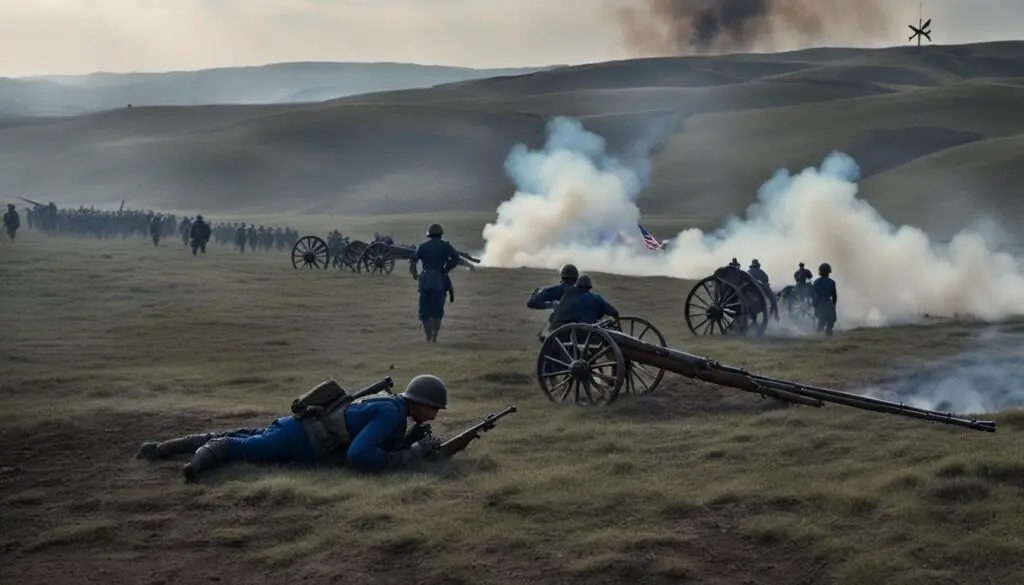
The Civil War saw the emergence of iconic figures such as General Robert E. Lee, who led the Confederate forces, and General Ulysses S. Grant, who commanded the Union Army. It was characterized by major battles, including the First Battle of Bull Run, the Battle of Gettysburg, and the siege of Vicksburg. These battles, along with countless others, resulted in immense loss of life and devastation on both sides.
In the end, the Union was victorious, and slavery was abolished with the ratification of the Thirteenth Amendment to the United States Constitution. The Civil War forever altered the nation’s understanding of itself and its commitment to equality. It remains a divisive and deeply significant chapter in American history, reminding us of the enduring struggle for freedom and justice.
Comparing Casualties
| Union | Confederacy | |
|---|---|---|
| Total Soldiers | 2,213,363 | 1,050,000 |
| Killed in Action | 110,070 | 94,000 |
| Wounded | 275,175 | 194,026 |
| Captured or Missing | 211,411 | 462,634 |
The table above provides a glimpse into the staggering human cost of the Civil War. The Union suffered a higher number of total soldiers, but the Confederacy had a higher proportion of casualties, given its smaller population. These numbers illustrate the immense sacrifice made on both sides of the conflict, as families and communities grappled with the loss and devastation caused by the war.
World Wars: A Global Stage
The United States played a significant role in both World War I and World War II. These global conflicts had a profound impact on the nation and the world, shaping the course of history in the 20th century.
World War I, which began in 1914 and ended in 1918, saw the United States join the Allied Powers composed of countries such as France, Great Britain, and Russia, to fight against the Central Powers, which included Germany, Austria-Hungary, and the Ottoman Empire. The U.S. entry into the war in 1917 played a crucial role in tipping the balance in favor of the Allies, ultimately leading to their victory. The war brought significant changes to modern warfare, with the introduction of new weapons and tactics, such as trench warfare and the use of chemical weapons.
World War II, which started in 1939 and ended in 1945, began with the devastating surprise attack on Pearl Harbor by the Japanese forces on December 7, 1941. This attack prompted the United States to enter the war and join the Allied Powers once again, this time against the Axis Powers consisting of Germany, Italy, and Japan. The war witnessed major battles and campaigns across the globe, from the beaches of Normandy during D-Day to the Pacific theater, where the U.S. engaged in fierce battles with Japan. The conflict culminated in the use of atomic bombs on the Japanese cities of Hiroshima and Nagasaki, leading to Japan’s surrender and the end of the war.
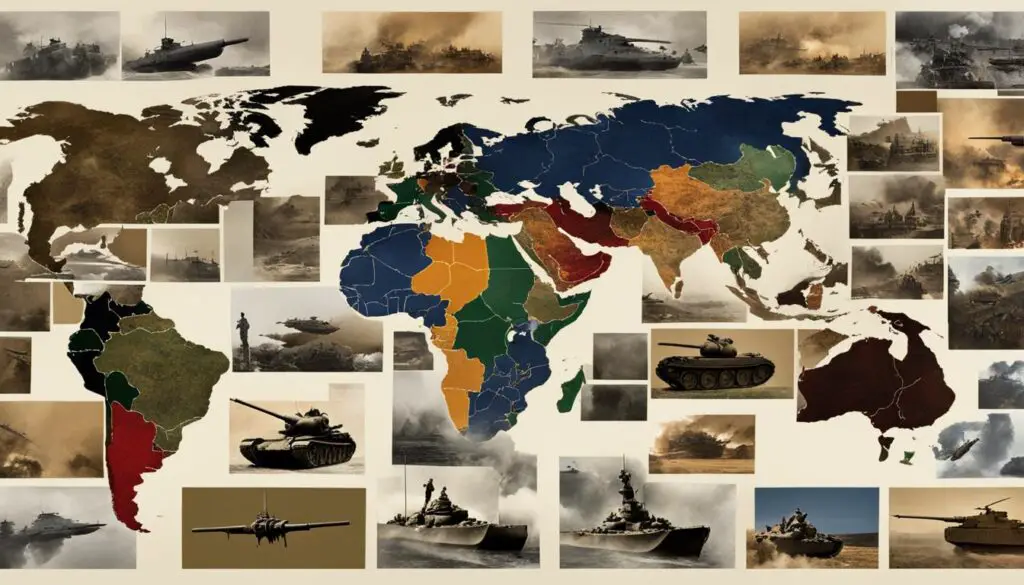
The Korean War: Cold War Conflict
The Korean War, fought from 1950 to 1953, was a Cold War conflict between North Korea, supported by the Soviet Union and China, and South Korea, supported by the United States and its allies. It emerged as a result of the geopolitical tensions between the two superpowers, with Korea becoming a divided nation after World War II.
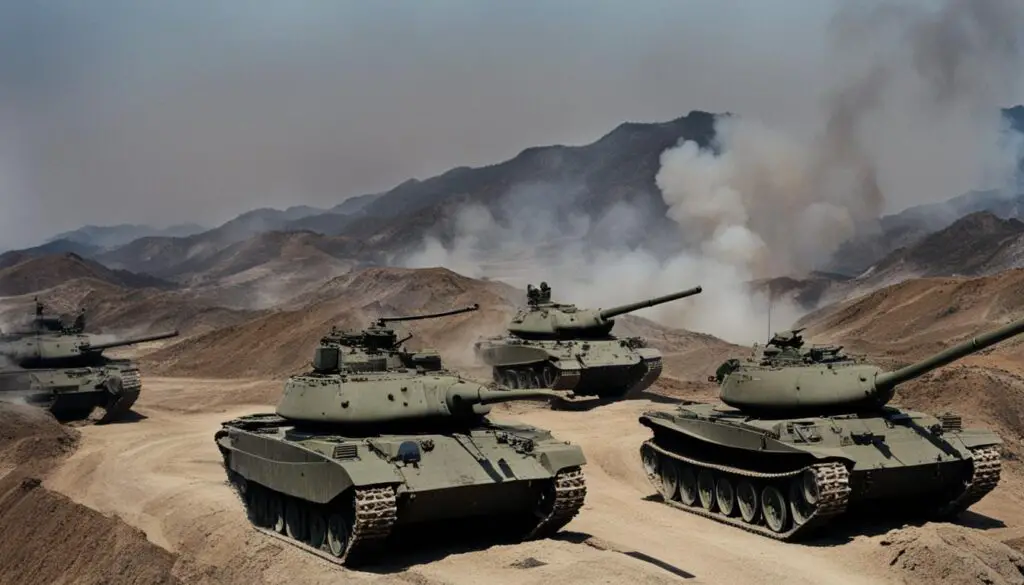
The war began on June 25, 1950, when North Korean forces launched a surprise attack on South Korea, aiming to reunify the peninsula under communist rule. The United States, as part of its containment policy against communism, quickly intervened to support South Korea. This marked the first military action of the Cold War, a period of heightened tensions between the United States and the Soviet Union.
Stalemate and Armistice
The Korean War saw significant battles and military strategies from both sides, including the Battle of Inchon and the Chosin Reservoir campaign. However, despite considerable efforts and casualties, the war reached a stalemate, and no clear victory was achieved by either side.
After three years of intense fighting, negotiations for an armistice began in July 1951. It took more than two years to reach an agreement, with the signing of the Korean Armistice Agreement on July 27, 1953. This agreement established the Korean Demilitarized Zone (DMZ) as a buffer zone between North and South Korea, effectively ending the active hostilities.
Legacy and Impact
The Korean War had lasting effects on the Korean Peninsula and the broader Cold War dynamics. It reinforced the division between North and South Korea, with the two countries remaining in a state of tension and occasional conflict to this day. The United States, through its intervention in the Korean War, demonstrated its commitment to containing communism and defending its allies.
The Korean War also highlighted the challenges of fighting a limited war in the age of nuclear weapons. It served as a precursor to future Cold War conflicts, such as the Vietnam War, where the United States faced similar dilemmas and struggled to achieve decisive victories.
| Key Facts | Details |
|---|---|
| Duration | 1950-1953 |
| Main Belligerents | North Korea, supported by the Soviet Union and China; South Korea, supported by the United States and its allies |
| Casualties | Estimated over 5 million military and civilian casualties |
| Outcome | Stalemate, division of Korea into North and South, establishment of the Korean Demilitarized Zone (DMZ) |
The Vietnam War: Controversial Conflict
The Vietnam War, which took place from 1955 to 1975, was a highly controversial conflict that played a significant role in the context of the Cold War. It was fought between North Vietnam, supported by the Soviet Union and China, and South Vietnam, supported by the United States and its allies. The war stemmed from the deep-rooted political division between the communist forces in the North and the non-communist government in the South.
The Vietnam War not only witnessed intense military engagements but also ignited a strong anti-war movement within the United States. The conflict raised ethical concerns and became a focal point for protests, with many Americans questioning the country’s involvement and the justification for the war. These sentiments were fueled by the heavy casualties, the use of controversial tactics like defoliation and napalm, and the lack of a clear military objective.
Despite the withdrawal of American troops in 1973, the war continued until 1975 when North Vietnam successfully captured Saigon, marking the formal reunification of Vietnam. The Vietnam War remains a complex and divisive chapter in US history, highlighting the challenges and consequences of intervening in foreign conflicts.
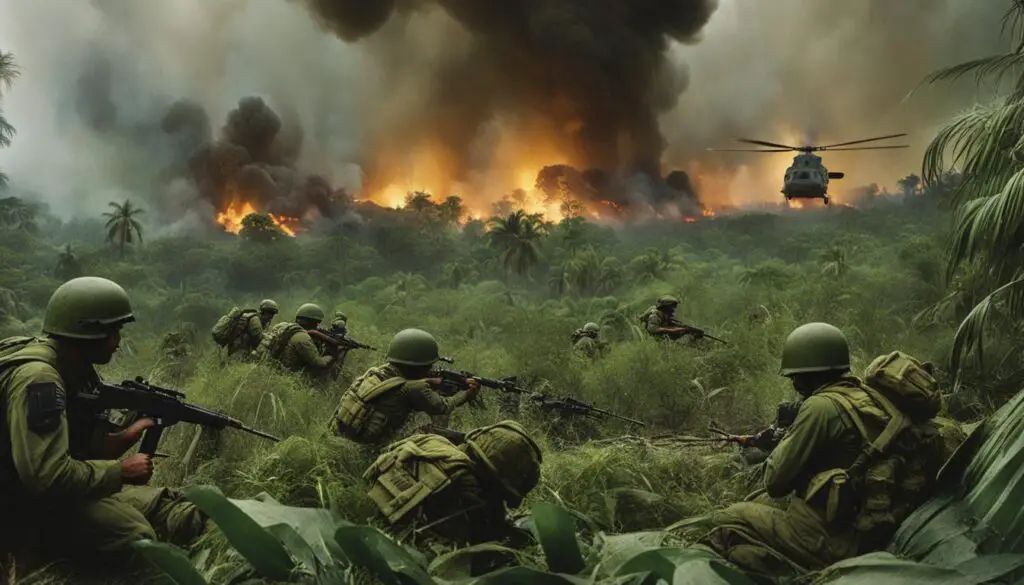
Involvement and Impact
The United States’ involvement in the Vietnam War had a profound impact on both the nation and its global standing. It marked a turning point in American foreign policy and led to a shift in public opinion, spawning a movement focused on peace, civil rights, and opposition to military intervention. The war also revealed the limitations of conventional military tactics in asymmetric warfare and underscored the importance of public support for military engagements.
Legacy and Lessons
The Vietnam War has left a lasting legacy on American society and its approach to conflicts. It prompted a reassessment of military intervention and advocacy for diplomatic solutions. Additionally, the war highlighted the importance of understanding cultural and historical contexts when engaging in foreign affairs. The lessons learned in Vietnam continue to shape US foreign policy decisions, ensuring a more nuanced and cautious approach to future conflicts.
Wars with the Middle East: Gulf War and War on Terror
In the 1990s and the 21st century, the United States has been engaged in conflicts in the Middle East. Two significant wars that have shaped the global landscape are the Gulf War and the War on Terror. These wars were driven by geopolitical concerns, the fight against terrorism, and the quest for regional stability.
The Gulf War: Operation Desert Storm
The Gulf War, also known as Operation Desert Storm, took place from 1990 to 1991. It was a response to Iraq’s invasion of Kuwait, which threatened the stability of the region and its oil reserves. Led by a coalition of international forces, including the United States, the Gulf War aimed to liberate Kuwait and neutralize Iraq’s military capabilities.
The swift and decisive actions of the coalition forces led to the successful liberation of Kuwait. The use of advanced military technology, such as precision airstrikes, played a crucial role in minimizing casualties and achieving the mission’s objectives. The Gulf War showcased the United States’ military capabilities and demonstrated its commitment to maintaining stability in the Middle East.
The War on Terror: Afghanistan and Iraq
The War on Terror, which began in 2001, was a direct response to the terrorist attacks on September 11th. The United States, along with its allies, initiated military operations in Afghanistan to dismantle al-Qaeda and remove the Taliban regime, which harbored terrorist organizations. The invasion of Afghanistan aimed to eliminate the safe havens for terrorists and disrupt their networks.
Subsequently, the War on Terror expanded to include the invasion of Iraq in 2003. The goal was to remove Saddam Hussein’s regime, dismantle his alleged weapons of mass destruction program, and foster a democratic government. However, the invasion and subsequent occupation of Iraq proved to be more challenging than anticipated, leading to a prolonged conflict and sectarian tensions.
Conclusion
The Gulf War and the War on Terror have significantly influenced the geopolitical landscape of the Middle East and the global fight against terrorism. These wars have showcased the United States’ military capabilities, highlighted the challenges of asymmetric warfare, and underscored the complexities of nation-building in volatile regions. Understanding the causes, strategies, and consequences of these conflicts is crucial for comprehending the United States’ role in the world and shaping future foreign policy decisions.
| War | Dates | Main Objective | Key Players |
|---|---|---|---|
| Gulf War | 1990-1991 | Liberate Kuwait, neutralize Iraq | United States, coalition forces, Iraq |
| War on Terror | 2001-present | Combat terrorism, stabilize Afghanistan and Iraq | United States, NATO, Afghanistan, Iraq |
Major Battles and Historical Context
Throughout US history, there have been numerous major battles that have played significant roles in shaping the nation’s military campaigns and historical conflicts. These battles span different time periods and have had lasting effects on the course of American history.
Battle of Gettysburg
One of the most iconic battles in American history is the Battle of Gettysburg, which took place from July 1 to 3, 1863, during the Civil War. This battle was a turning point in the war and marked a major victory for the Union. It was the bloodiest battle of the entire conflict, with over 50,000 casualties. The Union’s successful defense of Gettysburg demonstrated the resilience and determination of the Union forces, while dealing a significant blow to the Confederacy. The battle also paved the way for President Abraham Lincoln’s famous Gettysburg Address, which emphasized the importance of preserving the Union and the ideals of freedom and equality.
The Alamo
The Battle of the Alamo, fought from February 23 to March 6, 1836, was a pivotal event in the Texas Revolution. The battle took place at the Alamo Mission in San Antonio, Texas, where a small group of Texian rebels, including famous figures like Davy Crockett and Jim Bowie, defended the mission against the Mexican army led by General Santa Anna. Although the Texians ultimately lost the battle, their fierce resistance and determination inspired others to join the fight for Texas independence. The Battle of the Alamo became a symbol of courage and sacrifice in the struggle for freedom.
D-Day and the Battle of Midway
Two important battles during World War II were D-Day and the Battle of Midway. D-Day, which occurred on June 6, 1944, was the largest amphibious invasion in history and marked the beginning of the end for the Axis Powers. The Allied forces, primarily composed of American, British, and Canadian troops, stormed the beaches of Normandy in France, leading to the liberation of Western Europe from Nazi control. The Battle of Midway, fought from June 4 to 7, 1942, was a naval battle between the United States and Japan in the Pacific Theater. It was a decisive victory for the United States and marked a turning point in the war in the Pacific. The Battle of Midway crippled the Japanese navy and gave the United States a strategic advantage in the Pacific campaign.
Table: Major Battles in US History
| Battle | Date | War/Conflict |
|---|---|---|
| Battle of Gettysburg | July 1-3, 1863 | Civil War |
| The Alamo | February 23 – March 6, 1836 | Texas Revolution |
| D-Day | June 6, 1944 | World War II |
| Battle of Midway | June 4-7, 1942 | World War II |
Conclusion
The history of US wars is a testament to the nation’s resilience and determination. From the American Revolution to the ongoing War on Terror, these conflicts have molded the United States into the global power it is today. Each war has brought forth unique challenges and victories, leaving a lasting impact on the nation’s identity.
These wars have not only shaped the United States domestically but have also influenced its role in the world. The fight for independence and subsequent battles against imperialism and terrorism have demonstrated the nation’s commitment to its ideals of freedom, democracy, and justice.
Understanding the significance and historical context of US wars is crucial for comprehending the nation’s journey. By studying major battles and the motivations behind these conflicts, we gain a deeper understanding of the sacrifices made by those who fought, the lessons learned, and the ongoing pursuit of peace.
In conclusion, US wars have shaped the destiny of a nation, revealing its strength and character in times of adversity. As we reflect on the past, we must continue to strive for a future where diplomacy and understanding prevail, and where conflicts are resolved without violence. Only by remembering our history can we work towards a more peaceful and harmonious tomorrow.
FAQ
What are the major wars in US history?
The major wars in US history include the American Revolution, the Civil War, World War I, World War II, the Korean War, the Vietnam War, and the wars in the Middle East such as the Gulf War and the War on Terror.
When did the American Revolution take place?
The American Revolution took place from 1775 to 1783.
What were the key figures and milestones of the American Revolution?
Key figures of the American Revolution include George Washington, and important milestones include the signing of the Treaty of Paris.
When was the Civil War fought?
The Civil War was fought from 1861 to 1865.
What were the key issues and figures of the Civil War?
The key issues of the Civil War were states’ rights and slavery. Key figures include Robert E. Lee and Ulysses S. Grant.
When did the United States participate in World War I and World War II?
The United States participated in World War I from 1917 to 1918 and in World War II from 1941 to 1945.
What were the major events that led the US to join World War II?
The major events that led the US to join World War II were the Japanese attack on Pearl Harbor and the subsequent declaration of war by the United States.
When was the Korean War fought?
The Korean War was fought from 1950 to 1953.
Who were the main parties involved in the Korean War?
The main parties involved in the Korean War were North Korea, supported by the Soviet Union and China, and South Korea, supported by the United States and its allies.
When did the Vietnam War take place?
The Vietnam War took place from 1955 to 1975.
What were the main factors and controversies surrounding the Vietnam War?
The Vietnam War was a Cold War proxy war, with the United States supporting South Vietnam against the communist forces of North Vietnam. It was highly controversial, with protests and an anti-war movement in the United States.
When did the Gulf War and the War on Terror occur?
The Gulf War took place in 1990-1991, and the War on Terror began in 2001 with the US invasion of Afghanistan and later expanded to include the invasion of Iraq in 2003.
What were the goals of the Gulf War and the War on Terror?
The Gulf War aimed to respond to Iraq’s invasion of Kuwait, while the War on Terror aimed to combat terrorism and stabilize the Middle East region.
Are there any decisive battles that played a significant role in US wars?
Yes, there are several decisive battles that played a significant role, such as Gettysburg, the Alamo, D-Day, and the Battle of Midway.
What is the historical significance of these major battles?
Each battle holds its own historical significance and contributes to the overall understanding of US wars and the nation’s military campaigns.
How have US wars shaped the nation and its role in the world?
US wars from the American Revolution to battles against imperialism and terrorism have shaped the United States and its ideals, from the fight for independence to combating totalitarian regimes and terrorism.
Source Links
- https://www.battlefields.org/learn/articles/overview-american-revolutionary-war
- https://www.battlefields.org/learn/articles/brief-overview-american-civil-war
- https://study.com/academy/lesson/us-wars-timeline-history.html
